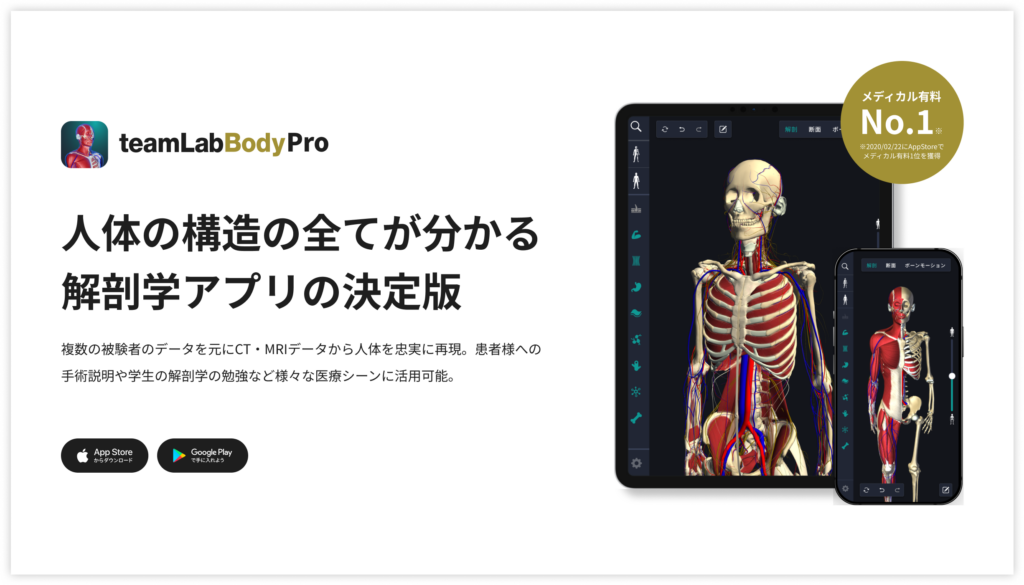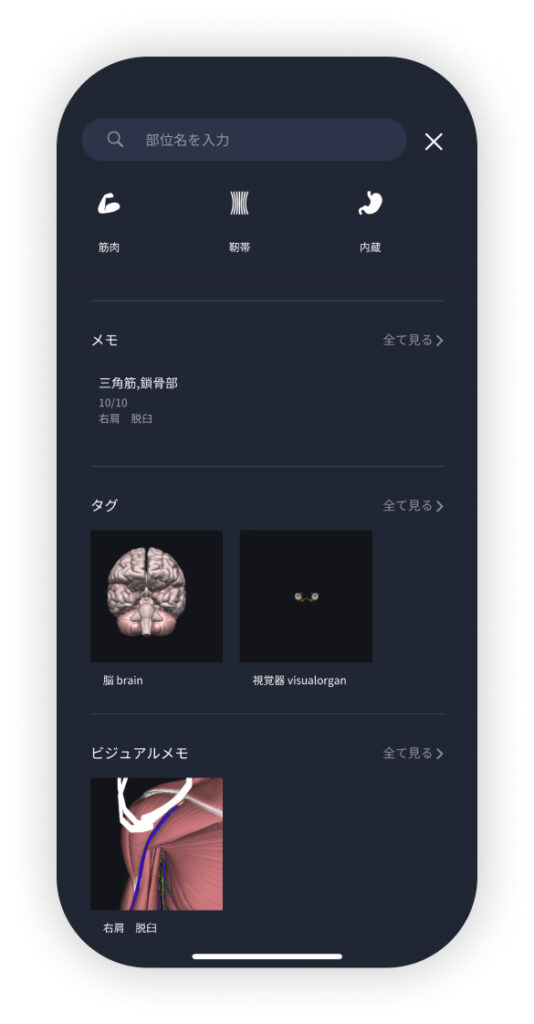beginning
In this article, I will explain effective study methods, starting with knowledge of specialized parts in human anatomy.
In human anatomy, it is necessary not only to memorize the names of various organs, muscles, and bones, but also to remember where they are located in the body. Therefore, it is necessary to learn as efficiently as possible.
I hope you will deepen your understanding even a little by reading this article and using the app.
Now, I'll explain the details about the “lower oblique muscle” and how to study human anatomy.
teamLab Body Pro Free Download
A 3D anatomy app that shows all the structures of the human body
Download teamLab Body Pro here!

What is the lower oblique muscle?
The anatomy application allows you to view a selection of anatomy 3D models. In this model, there are various observation methods such as surfaces, cross-sections, and nervous systems. This time, I'll explain using an anatomy application.
About the lower oblique muscle

Obliquus capitis muscle (obliquus capitis muscle) is a short deep muscle belonging to the suboccipital muscle group and plays an important role in head rotation. This line isSpinal process of the second cervical vertebra (axial vertebra)It starts with,transverse process of the 1st cervical vertebra (atypical spine)It stops at
What is characteristic is that even though “capitis (head)” is attached to the name, it does not adhere to the skull. The main effect is to rotate the head to the same side, which is particularly involved in the movement of turning the gaze sideways.
Also, near this streakvertebral arteryandsuboccipital nerveIt is running, and clinically, a connection with “inferior occipital nerve syndrome” and head tension headaches has also been pointed out. It is located in the deep layer, and along with other lower occipital muscles (oblique superior muscle, rectus occipital muscle, etc.), it is an important muscle involved in head stability and fine movement.
Study points
Anatomical understanding: accurately grasp deep structures
The oblique inferior muscle is part of the lower occipital muscle group in the deepest part of the neck.From the spines of the axial vertebrae to the transverse processes of the atypical vertebraeIt runs diagonally to Since it is covered by superficial muscles and is difficult to see, it is important to grasp the position three-dimensionally using an anatomical diagram or 3D application.
Also, in parallel with running on this routevertebral arteryandsuboccipital nerveis running, and understanding of clinical applications is also deepened by being aware of the relationship between muscles and nerves/blood vessels. In addition, learning efficiency will increase if you learn positional relationships with other lower occipital muscles (rectus occipital muscle, oblique superior occipital muscle) as a set.
Functional understanding: learning in conjunction with head rotation
The lower oblique muscle is mainlyipsilateral rotation of the headIt's a muscle involved in. When learning, it is effective to slowly perform the movement of turning one's head left and right, and imagine the function of deep muscles involved in that movement.
Also, when posture or muscle tone increases, it may cause dull pain in the back of the head or tension-type headaches, soHead movement and muscle tensionIf you learn by connecting them together, it will be easier to stay in your memory. Since the location of the muscles is deep, palpation is difficult, but understanding deepens by being aware of the linkage with peripheral muscles.
Practical application: deepening knowledge through clinical relevance
It passes close to the lower oblique musclesuboccipital nerveWhen compressed, symptoms such as headaches and numbness in the back of the head called “suboccipital nerve syndrome” appear. As a result, it is said that relieving muscle tension, stretching, and improving posture will lead to treatment and prevention.
Therefore, in clinical practice, it is not just about memorizing muscle positions,What kind of symptoms are associated with it, and what attitudes increase the burdenIt is important to apply knowledge from this point of view. Also, since it is a target muscle for rehabilitation and manipulative treatment, etc., learning by linking function with clinical findings leads to practical anatomical understanding.
How to study human anatomy
I will explain specific study methods using human anatomy applications.
Check your past learning history and practice repeatedly
Here are the steps to check your anatomy learning history and practice iteratively effectively.
1. Check your learning history in the app
Reviewing your learning history with the application is an important step in effectively advancing anatomy learning. First, launch the app and go to the learning history section from the main menu. Many anatomy apps are designed to show your progress in the form of graphs and lists, so you can visually check which parts you've learned about and how much time you've spent.
By using this data, you can understand which areas you have strengths in and where you need to spend more time and effort. We also recommend using a dedicated tag or notebook function to mark areas you are particularly weak at or where you need to relearn. Regularly checking your learning history and looking back on past learning content will lead to efficient review and deepening understanding.
2.Make a plan for iterative learning
Making an efficient repetitive learning plan based on learning history is extremely effective in promoting knowledge retention. First, identify weak points and areas where you need to relearn. Next, arrange these study items into a weekly or monthly calendar and create a specific study schedule. By proceeding in a planned manner, you can learn each part evenly and avoid packing in a large amount of information at once.
Using a task management app or digital calendar to set study reminders is effective. Also, it's important to have the flexibility to regularly review progress and revise plans as needed. By having goals and proceeding with your studies in a planned manner, you can efficiently acquire anatomical knowledge.
3.Use 3D features to learn visually
By utilizing the 3D function, learning anatomy is easier to understand visually. The 3D model shows the structure of the human body three-dimensionally, and each part can be observed in detail. This makes it possible to intuitively grasp positional relationships between deep muscles and organs that are difficult to capture in a planar view. For example, you can learn even the smallest details by rotating specific muscles and bones and zooming in and out.
Also, there are many apps that have the function of displaying cross-sectional views of each part using a 3D model, which is useful for deepening understanding of internal structures. This diversity of visual information helps with memory retention and improves immediate responsiveness in tests and practice situations. By utilizing the 3D function and learning visually, you can learn anatomy knowledge more deeply and efficiently.
Use the memo function concretely

Make notes so you don't forget the things and points you've noticed while studying. The memo function can be used for different purposes, such as inputting text, saving images, and writing memos. Tag your notes to make them easier to review later.
Test your learning regularly in the form of quizzes
Regularly testing what you've learned in a quiz format is a very effective way to anchor your anatomy knowledge. Quiz-style tests help you objectively grasp your level of understanding and areas you lack while repeating knowledge.
For example, by using a learning app to conduct quizzes every specific period, you can reconfirm what you've learned and strengthen your memory. There are a wide range of quiz formats, such as multiple choice questions, fill-in-the-blank questions, and short answer questions, and each helps understanding from a different angle and develops the ability to utilize various types of knowledge.
Get feedback
If possible, get feedback from other learners and experts. It helps you find your own gaps in understanding and areas for improvement. You can also keep yourself motivated to learn by regularly testing yourself. Feeling a sense of accomplishment and progress increases motivation for continuous learning.
summary
This time, I explained how to study “lower oblique muscles” using an application!
Thank you for reading this far.
I would be happy if reading this article helped you learn about anatomy.
Learning is a long, never-ending journey, but I sincerely wish you all the best. Let's continue to study together and work hard for the national exam!
Please look forward to the next blog.
teamLab Body Pro Free Download
A 3D anatomy app that shows all the structures of the human body
Download teamLab Body Pro here!





